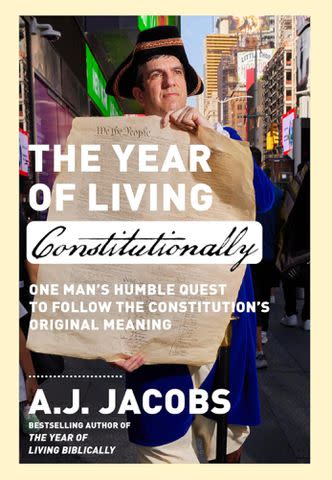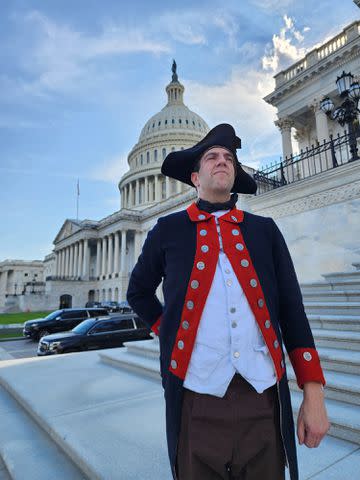A.J. Jacobs reveals the 5 weirdest things about the Constitution
- Oops!Something went wrong.Please try again later.
"The Year of Living Constitutionally" author found some odd quirks in America's most famous document.
A.J. Jacobs does not have any issues when it comes to commitment. The celebrated author has already tried to follow the Bible literally (The Year of Living Biblically), become the smartest person in the world (The Know-It-All), achieve bodily perfection (Drop Dead Healthy) and solve the world’s greatest puzzles (The Puzzler).
For his next mission (and book), Jacobs attempted to live the Constitution as literally as possible, and the hilarious result is The Year of Living Constitutionally (available for pre-order now for May 7 release), in which the author wrote pamphlets by quill and candlelight, allowed soldiers to quarter in his apartment, bore a musket around the Upper West Side of New York, and met with Congress to try to get a license to be a pirate/privateer… as one does.
And while learning how to live constitutionally, Jacobs also learned some fascinating facts about the Constitution. Here, the author — and former Entertainment Weekly writer and editor — presents the five weirdest quirks he uncovered about America’s most famous document.

Crown
'The Year of Living Constitutionally' by A.J. JacobsThe Constitution is full of typos
The Constitution has some of the most inspiring writing ever created by humans, including those three glorious words “We the people.” It also has a bunch of typos. Or whatever the eighteenth century equivalent is (quillos?).
Granted, spelling was different then, so I’m not going to complain about words such as chusing. But what about the two different spellings of the Keystone State: Pennsylvania and Pensylvania? How did the state somehow lose an N in its journey from the first page to the fourth page? It’s anoying.
Plus, there is an extraneous apostrophe in one of the “it’s”es in Article II. It should be “its,” no apostrophe. That’s a classic mistake that would have gotten a thousand snarky social media comments if Ben Franklin had invented social media.
That’s not to mention grammar. I decided to run the entire text of the Constitution through the Grammarly software. Grammarly was not impressed. It found 663 problems. It complained, for instance, that the Second Amendment has an “incorrect form of the verb ‘being’” and said, “Consider changing it.”
On the upside, I do think the flubs in spelling and grammar point to an important truth we shouldn’t forget: The Constitution is a brilliant document, but an imperfect one written by humans, not dictated by an infallible deity.
The Constitution is crazy hard to amend
How hard is it to amend the Constitution? Harder than all the Ethan Hunt missions combined. Consider that since America’s birth, Congress has officially considered 10,524 constitutional amendments. Of those, 27 were ratified. That’s a failure rate of 99.74 percent.
I found a series of books listing the 99.74 percent of proposals that made it to the congressional floor but soon sputtered out. They range from inspiring and idealistic (a 1927 amendment to prohibit war) to horrifying (a 1913 amendment to ban marriage between the races.) Some are just bizarre, such as the 1893 proposal to rename this nation the United States of the Earth, which seems quite the overreach. The Founders didn’t mean for it to be so difficult to change, but they failed to see the rise of two rigid political parties.

Crown
'The Year of Living Constitutionally' author A.J. Jacobs at the CapitolThe Constitution was created by 55 people… and several animals
In addition to the fifty-five delegates at the Constitutional Convention, it took a small barnyard to make our founding document possible. The Constitution was written with the quill from a goose (some fancy writers preferred the swan feather, but the Constitution’s scribe used a goose). The Constitution’s ink was made from the nests of wasp larvae. And the Constitution itself was written on parchment, which is calfskin (or sheepskin or goatskin, but most likely calfskin in the case of the Constitution). To soften the parchment before the writing, it was soaked in an alkali stew made up partly from urine from other unspecified animals.
The Constitution contains a section on government-sanctioned piracy
It’s actually called privateering. But the basic idea is legalized, government-approved piracy. In Article I, Section 8, Congress is given the power to grant citizens a “letter of marque and reprisal.” This is a document that allows a private citizen with a seafaring vessel — say a fisherman — to load guns and cannons on board and go after enemy ships. If you captured an enemy ship, you get to keep the booty. This was actually hugely important during the Revolutionary War. America didn’t have much of a Navy, so the government outsourced naval battles. Privateers captured about two thousand British vessels during the Revolutionary War. Congress has not granted a letter of marque and reprisal since 1815, but the passage remains in the Constitution. (And I tried to get one as part of my book).

Sharon Schuur
Author A.J. JacobsThe Constitution was written in a haze of smoke and drink
The eighteenth-century was not a good time for teetotalers. Day-drinking and night-drinking were both the norm, and the Founding Fathers were no exception. In fact, there is a famous bar bill for a party thrown for George Washington in Philadelphia in the last weeks of the Constitutional Convention. The party had 55 attendees, and the bill included: “54 bottles of Madeira, 60 bottles of Claret, 8 bottles of Whiskey, 22 bottles of Porter, 8 bottles of Hard Cider, 12 of Beer, and seven bowls of Alcoholic Punch.”
That’s not to mention the smoking. The Founders favored clay tobacco pipes. For those who didn’t bring their own, there were communal pipes available for borrowing. By the way, the windows in Independence Hall were shut during the entire length of the convention for fear of eavesdroppers — so even if you didn’t smoke yourself, you were still putting your lungs to the test.
Related content:
Read the original article on Entertainment Weekly.

